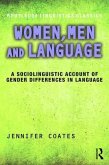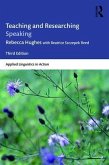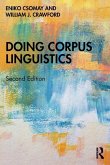- Broschiertes Buch
- Merkliste
- Auf die Merkliste
- Bewerten Bewerten
- Teilen
- Produkt teilen
- Produkterinnerung
- Produkterinnerung
Projects in Linguistics and Language Studies, Third Edition, provides practical guidance for undergraduate students on how to plan, prepare and present a research project in linguistics or English language studies.
Andere Kunden interessierten sich auch für
![Women, Men and Language Women, Men and Language]() Jennifer Coates (UK University of Roehampton)Women, Men and Language57,99 €
Jennifer Coates (UK University of Roehampton)Women, Men and Language57,99 €![Teaching and Researching Speaking Teaching and Researching Speaking]() Rebecca HughesTeaching and Researching Speaking62,99 €
Rebecca HughesTeaching and Researching Speaking62,99 €![Exploring the French Language Exploring the French Language]() R LodgeExploring the French Language55,99 €
R LodgeExploring the French Language55,99 €![Investigating a Corpus of Historical Oral Testimonies Investigating a Corpus of Historical Oral Testimonies]() Chris FitzgeraldInvestigating a Corpus of Historical Oral Testimonies41,99 €
Chris FitzgeraldInvestigating a Corpus of Historical Oral Testimonies41,99 €![Doing Corpus Linguistics Doing Corpus Linguistics]() Eniko CsomayDoing Corpus Linguistics42,99 €
Eniko CsomayDoing Corpus Linguistics42,99 €![Doing Corpus Linguistics Doing Corpus Linguistics]() Eniko CsomayDoing Corpus Linguistics154,99 €
Eniko CsomayDoing Corpus Linguistics154,99 €![English Transcription Course English Transcription Course]() Maria LecumberriEnglish Transcription Course59,99 €
Maria LecumberriEnglish Transcription Course59,99 €-
-
-
Projects in Linguistics and Language Studies, Third Edition, provides practical guidance for undergraduate students on how to plan, prepare and present a research project in linguistics or English language studies.
Produktdetails
- Produktdetails
- Verlag: Taylor & Francis Ltd
- 3 ed
- Seitenzahl: 328
- Erscheinungstermin: 30. März 2012
- Englisch
- Abmessung: 246mm x 174mm x 18mm
- Gewicht: 612g
- ISBN-13: 9781444145366
- ISBN-10: 1444145363
- Artikelnr.: 34573928
- Herstellerkennzeichnung
- Libri GmbH
- Europaallee 1
- 36244 Bad Hersfeld
- gpsr@libri.de
- Verlag: Taylor & Francis Ltd
- 3 ed
- Seitenzahl: 328
- Erscheinungstermin: 30. März 2012
- Englisch
- Abmessung: 246mm x 174mm x 18mm
- Gewicht: 612g
- ISBN-13: 9781444145366
- ISBN-10: 1444145363
- Artikelnr.: 34573928
- Herstellerkennzeichnung
- Libri GmbH
- Europaallee 1
- 36244 Bad Hersfeld
- gpsr@libri.de
Alison Wray, Research Professor, Centre for Language and Communication Research, Cardiff University. Aileen Bloomer, formerly Principal Lecturer in Language Studies and Linguistics, York St John University College.
Preface to the third edition Acknowledgements International Phonetic
Alphabet Chapter 1: Introduction: starting on the right foot PART I: AREAS
OF STUDY AND PROJECT IDEAS Chapter 2: Psycholinguistics Chapter 3:
First-language acquisition and development Chapter 4: Second-language
acquisition Chapter 5: Structure and meaning Chapter 6: Style in spoken and
written texts Chapter 7: Sociolinguistics Chapter 8: Language and gender
Chapter 9: Accents and dialects of English Chapter 10: History of English
Chapter 11: Computer-mediated communication PART II: TECHNIQUES FOR
COLLECTING DATA Chapter 12: Audio- and video-recorded data Chapter 13:
Experiments Chapter 14: Questionnaires, interviews, and focus groups
Chapter 15: Observation and case studies Chapter 16: Ethical considerations
in research projects PART III: TOOLS FOR DATA ANALYSIS Chapter 17:
Transcribing speech phonetically and phonemically Chapter 18: Transcribing
speech orthographically Chapter 19: Using computers to study texts Chapter
20: Statistics and your project PART IV: PRESENTING YOUR WORK Chapter 21:
How to reference Chapter 22: Plagiarism and how to avoid it Chapter 23:
Handy hints on writing good academic English Chapter 24: Hints on giving a
good oral presentation References Index
Alphabet Chapter 1: Introduction: starting on the right foot PART I: AREAS
OF STUDY AND PROJECT IDEAS Chapter 2: Psycholinguistics Chapter 3:
First-language acquisition and development Chapter 4: Second-language
acquisition Chapter 5: Structure and meaning Chapter 6: Style in spoken and
written texts Chapter 7: Sociolinguistics Chapter 8: Language and gender
Chapter 9: Accents and dialects of English Chapter 10: History of English
Chapter 11: Computer-mediated communication PART II: TECHNIQUES FOR
COLLECTING DATA Chapter 12: Audio- and video-recorded data Chapter 13:
Experiments Chapter 14: Questionnaires, interviews, and focus groups
Chapter 15: Observation and case studies Chapter 16: Ethical considerations
in research projects PART III: TOOLS FOR DATA ANALYSIS Chapter 17:
Transcribing speech phonetically and phonemically Chapter 18: Transcribing
speech orthographically Chapter 19: Using computers to study texts Chapter
20: Statistics and your project PART IV: PRESENTING YOUR WORK Chapter 21:
How to reference Chapter 22: Plagiarism and how to avoid it Chapter 23:
Handy hints on writing good academic English Chapter 24: Hints on giving a
good oral presentation References Index
Preface to the third edition Acknowledgements International Phonetic
Alphabet Chapter 1: Introduction: starting on the right foot PART I: AREAS
OF STUDY AND PROJECT IDEAS Chapter 2: Psycholinguistics Chapter 3:
First-language acquisition and development Chapter 4: Second-language
acquisition Chapter 5: Structure and meaning Chapter 6: Style in spoken and
written texts Chapter 7: Sociolinguistics Chapter 8: Language and gender
Chapter 9: Accents and dialects of English Chapter 10: History of English
Chapter 11: Computer-mediated communication PART II: TECHNIQUES FOR
COLLECTING DATA Chapter 12: Audio- and video-recorded data Chapter 13:
Experiments Chapter 14: Questionnaires, interviews, and focus groups
Chapter 15: Observation and case studies Chapter 16: Ethical considerations
in research projects PART III: TOOLS FOR DATA ANALYSIS Chapter 17:
Transcribing speech phonetically and phonemically Chapter 18: Transcribing
speech orthographically Chapter 19: Using computers to study texts Chapter
20: Statistics and your project PART IV: PRESENTING YOUR WORK Chapter 21:
How to reference Chapter 22: Plagiarism and how to avoid it Chapter 23:
Handy hints on writing good academic English Chapter 24: Hints on giving a
good oral presentation References Index
Alphabet Chapter 1: Introduction: starting on the right foot PART I: AREAS
OF STUDY AND PROJECT IDEAS Chapter 2: Psycholinguistics Chapter 3:
First-language acquisition and development Chapter 4: Second-language
acquisition Chapter 5: Structure and meaning Chapter 6: Style in spoken and
written texts Chapter 7: Sociolinguistics Chapter 8: Language and gender
Chapter 9: Accents and dialects of English Chapter 10: History of English
Chapter 11: Computer-mediated communication PART II: TECHNIQUES FOR
COLLECTING DATA Chapter 12: Audio- and video-recorded data Chapter 13:
Experiments Chapter 14: Questionnaires, interviews, and focus groups
Chapter 15: Observation and case studies Chapter 16: Ethical considerations
in research projects PART III: TOOLS FOR DATA ANALYSIS Chapter 17:
Transcribing speech phonetically and phonemically Chapter 18: Transcribing
speech orthographically Chapter 19: Using computers to study texts Chapter
20: Statistics and your project PART IV: PRESENTING YOUR WORK Chapter 21:
How to reference Chapter 22: Plagiarism and how to avoid it Chapter 23:
Handy hints on writing good academic English Chapter 24: Hints on giving a
good oral presentation References Index









